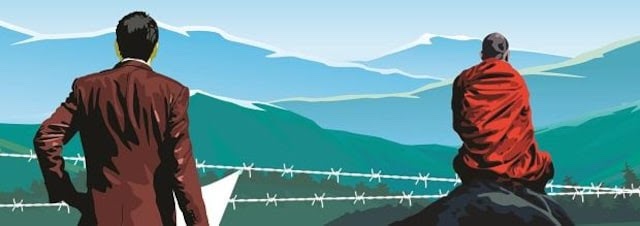
By Vikas Gupta
Defence News of India, 3 Mar 23
Since India’s independence in 1947, it has been described as myopic in its strategic outlook. George Tanham of the RAND Corporation postulated in 1992 that the country lacked a strategic culture, apparently because it had never faced an “existential threat”. Clearly, Tanham was unimpressed by six centuries of repeated invasions from Central Asia, nor by the bloody sacking of Delhi by Timur in 1398, nor by two hundred years of British colonial rule that reduced India from opulence to scarcity. Even so, it is true that, without a long-term national security strategy crafted by India’s political leadership, the country treats even its most pressing security challenges, such as its China policy, with a cavalier disregard for their implications.
In the 15 years since independence, New Delhi’s repeated rejection of Chinese suggestions to draw the Sino-Indian border through mutual consultation sparked a war in 1962 between the two Asian giants. Another major reason was Beijing’s sensitivity to India’s influence in Tibet, especially given the young Dalai Lama’s admiration for Prime Minister Jawaharlal Nehru. Chinese Communist Party (CCP) Chairman Mao Zedong, already suspicious of Nehru’s intentions in Tibet, was enraged when Chinese military repression in Lhasa in 1959 led the Dalai Lama to seek refuge in India, followed by tens of thousands Tibetan refugees. The refuge offered by New Delhi to the Dalai Lama and his fellow Tibetans was a major contributor to the 1962 Sino-Indian conflict and India’s humiliating defeat. To date, the aggressive behavior of the Chinese military – now called the People’s Liberation Army (PLA) – stems from Beijing’s internalized belief that India’s intentions towards Tibet are in bad faith and must be vigorously countered. in order to deter New Delhi.
In the nearly 65 years since then, China has become a formidable industrial, scientific, technological and military power that manages to bully most countries into acting as if Tibet is not at all a problem. At the same time, His Holiness the Dalai Lama has become a revered global figure and an example of resistance to religious and political repression. While most of the world community tows the Chinese line on the Dalai Lama, and kings, presidents and prime ministers avoid public meetings with him for fear of incurring China’s wrath, India – virtually alone in the world – enables the Tibetan refugee community to call India their home. Tibetans were allowed to set up a parliament in exile, calling it the Central Tibetan Administration as a fig leaf to cover up its overtly political nature. A network of Buddhist monasteries set up in India mirrors Tibet’s three great monasteries – Sera, Drebung and Ganden – diluting the effects of Chinese control over them.
Among the approximately 65,000 Tibetan refugees living in India, volunteers for military service against China are offering to be recruited into seven battalions of the Secret Frontier Force (SFF), made up mainly of descendants of Tibetan refugees who fled the crackdown China in the 1950s. These sturdy mountain soldiers proved their worth against the PLA in eastern Ladakh in the summer of 2020, capturing key heights south of Pangong Lake This force is equivalent to almost an infantry division of motivated and trained Tibetan paratroopers, armed with American small arms, who can be dropped far behind the PLA front lines to perform fifth column tasks – including mobilizing the Tibetan population and cutting lines of logistics life of the PLA. In addition, the Indian army has converted a mechanized strike corps into a mountain strike corps; and now Indian planners have the ability to vertically envelop forward PLA troops; with Tibetan-speaking SFF troops grouped in small numbers with regular Indian Army units. This would give Indian units an invaluable advantage while operating in an unfamiliar and foreign environment.
However, as Indian strategic planners may have noticed, all of these potential advantages over the Chinese depend heavily on one factor that appears increasingly fragile: the 14eDalai Lama and his inspirational leadership. Currently aged 87, he has optimistically predicted that he will live to be 113. While much of the world would welcome an exceptionally long life for the revered monk, both the Tibetan refugee community and Indian policymakers should have prepared in detail for a change. on guard. China’s security czars in Beijing and Lhasa have already indicated the line they are likely to take, which is to secure a favorable successor. According to traditional practice, the death of a Dalai Lama is followed by a search for reincarnation. This research is based on signs, such as the direction the late Dalai Lama was looking at when he died; the direction in which the smoke blew during his cremation and the statements of the oracles of Lhamo La-tso, a lake of vision in Tibet.
The 14theThe Dalai Lama, throwing tradition to the winds, has made it clear that he will ensure that his successor is supportive of India and the Tibetan refugee community in India. He put forward three options, each of which deviates from traditional practice. The first is that he would be reincarnated outside of Tibet; so far, two Dalai Lamas have been born outside of Tibet. Second, the Dalai Lama said that he could, in his lifetime, appoint a living successor. Finally, he speculated that his successor would be a woman – the first female Dalai Lama.
However, the Chinese are trying to ensure their control over the selection of the 15eDalai Lama. Beijing has already done this. After the death of the 10ePanchen Lama, the head of Tazhilhunpo Monastery in Shigatse, the Dalai Lama has declared a six-year-old boy named Gedhun Choekyi Nyima to be the next Panchen Lama – the second most important figure in Tibetan Buddhism. Three days after his announcement, the little boy disappeared and has not been seen since. In Tibet, the Chinese government has passed a law that says all senior lamas must be approved by Beijing.
In India, the Tibet Study Group simply watches, doing little to shape this contest in its own favor. Many options exist to ensure the next Dalai Lama is a favorable choice, but none of these choices have been exercised. Meanwhile, Xi Jinping is relocating Tibetan border villagers to “model villages” along the Line of Actual Control in Ladakh and the McMahon Line in Arunachal Pradesh, cementing China’s grip on the border. New Delhi is making tentative moves towards setting up a quadrangle – a grouping of Australia, India, Japan and the United States – but our failure to convince Washington has led to the establishment of AUKUS: A combat oriented grouping from Australia, United Kingdom and United States. Finally, China retains tight control over up to 1,000 square kilometers of territory it occupies in eastern Ladakh, while India appears to be praying and waiting.






